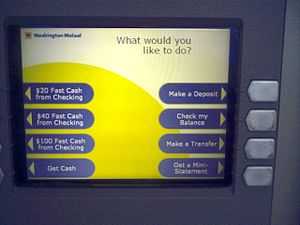Screen-labeled function keys

Screen-labeled function keys are a special case of function keys where keys are placed near a screen, which provides labels for them. These are most commonly found in kiosk applications, such as automated teller machines and gas pumps. They originated in aviation cockpits, such as the F-111.[citation needed].Hewlett-Packard developed them for use in computers/calculators in the 1970s.[citation needed] The HP 9830 desktop computer was the first calculator with two rows of 4 keys, over which a paper overlay would be placed. These were later adapted to terminals. Programmers found that the HP 2640 terminals could lock the top two lines of the screen, so they displayed the key functions there. Starting with HP 2647 terminal, the keys were re-arranged to correspond with 2 pairs of 4 labels at the bottom of the screen. These could be programmed by escape sequence or configuration screen. This would be further developed on the failed HP 300 Amigo, which used keys at the right side of the screen and HP 250 business computers which placed them at the bottom. By arranging functions in hierarchical trees, many functions can be implemented with only 8 keys.
Graphical calculators
As of 2008, HP calculators use this arrangement to implement hierarchical trees of functions.[citation needed] They are rarely found on PC applications, even though the first IBM PC BASIC labeled function key use at the bottom of the screen, and there were 12 function keys, patterned after use on IBM terminals.
Modern Texas Instruments calculators such as the TI-89 series use function keys to open drop-down menus on their menu bar, the menu title acting like the key label.
Casio calculators use the function keys for a menu at the bottom of the screen.